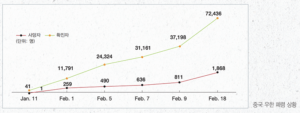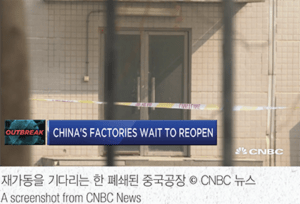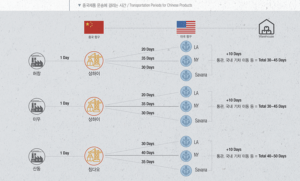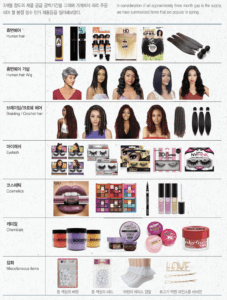Corona Shock, Stopped Factories!
Prepare for Back Order!
The economic fallout of a new coronavirus outbreak in Wuhan, Hubei Province in China continues to grow. The mainland China is on a lockdown in an effort to stop the virus from spreading, which resulted in a sudden shrinkage of economic activities. As the beauty supply industry relies heavily on Chinese manufacturers, many beauty supply businesses are incurring severe economic damages.
In response, BNB promptly prepared the following special Cover Story about the coronavirus epidemic and its impact on the beauty supply industry in addition to available countermeasures to the problem.
Part 1. A Complete Stop to Factories and Distribution
A crisis fueled by the government’s suppression on information
The first coronavirus case was identified on December 8th in Wuhan, China. While the pneumonia of unknown cause spread, the government stifled the dissemination of relevant information. Only 23 days later on December 31st, the government announced the outbreak to the public. Based on the careless assessment from the National Health Commission that human-to-human transmission is yet confirmed, more than five million people of Wuhan left the city at a time nearing Lunar New Year holidays. As a result, people from Wuhan, unaware of the seriousness of the virus outbreak, unknowingly spread the virus throughout the world. Only on January 21, 2020, Chinese government announced that human-to-human transmission cases were confirmed. In February, all ports and boarders were finally closed, and the government commenced a war against the virus including measures like grounding people living in infected areas.
The world’s factory shut down
To stop the virus from spreading, the Lunar New Year holidays were officially extended to February 9th, adding a week to the long holidays by the government, and the chimney of the World’s Factory went cold. Initially, the factories outside Wuhan were planned to resume their normal operation on February 10th, but not all of the factory workers could return to work by the time. More than half of the Chinese population, approximately 780 million people, were impacted by the travel restrictions imposed by the government in an effort to contain the virus.
Regardless, the government encouraged factories to resume production, but many factory owners who worried about epidemic were reluctant. A normal operation was impossible in many cases due to the missing workers. For some factories who desired to resume normal operation, the safety measures imposed, including wearing masks and other hygiene devices, disinfection of all factory areas twice a day, among others, were too high of a hurdle. Naturally, all factories in China were adversely impacted, which created a domino effect in the global supply chain.
Halt in manufacturing and transporting of beauty supply goods
The beauty supply industry felt the fallout directly due to its reliance on Chinese manufacturers. Most hair products and miscellaneous items are Chinese exports. In addition, many chemicals and cosmetics are manufactured in China.
Hair Products
Most hair products are produced through a labor-intense process requiring skilled workers. Automation is virtually impossible in many aspects, so no worker means no production. Many major production facilities of hair products are located in Henan province sharing the northern border of Hubei province. The biggest Chinese hair company, Rebecca Hair Product Co. Ltd. is also located in Xuchang, Henan, about four-hour drive to north from the city of Wuhan. Henan province reported the third most confirmed coronavirus patients and victims, which was only after Hubei and Guangdong.
In last February, we met a hair business owner from China in a beauty show held in Atlanta. He said, “the local government gave a direction not to open the factory until February 14th.” He added, “I don’t know if my factory could reopen after that date.” He was unsure about when he could return to China as the China-to-U.S. air travel ban was imposed right after he left China. He shared his doubts saying, “I don’t expect the factory to resume its operation by February.” His factory reportedly manufactures products that are supplied to big and well-known hair companies in the U.S.
Chemicals, Cosmetics, and Miscellaneous Goods
According to a beauty industry insider, “while not as much as hair, other goods are to be impacted as well” including chemicals, cosmetics, and miscellaneous items. Most chemicals and cosmetics are produced in the east coast of China, including Shandong and Guangdong provinces. An employee of a company running hair gel, edge control, and cosmetic manufacturing facilities in China reported that their operation would probably resume in the end of March.
Miscellaneous items are heavily manufactured in Zhejiang and Guangdong provinces, which recorded the number two and four for the infected population among Chinese provinces. Similarly, most factories producing miscellaneous items would not likely resume their operations in February.
When would it return to normal?
Before the beginning of Lunar New Year holidays, “the last shipment of Chinese beauty products to the U.S. was made on around January 20th,” most people associated with hair companies agreed. The shipment would arrive in the U.S. around mid-to-end of February.
The shipment should have resumed by the mid-to-end of February according to a regular production schedule upon the arrival of factory workers after the Lunar New Year holidays. However, the factory is set to shut its door in February due to the coronavirus.
Assuming a partial operation of factories and transportation of goods occur in coming March, the Chinese beauty supply shipments destined to the U.S. would back on track by the end of April at its earliest.
According to the scenario, the goods will arrive in the mid-May at the U.S. ports. As such, assuming the worst, there would be a minimum of three-month gap between the coming February arrival and next one.
A transportation crisis to follow the reopening of factories
After the production resumes, the goods must be transported to their destination. The queue of commercial carriers and transportation services would be an exceptionally long one. A transportation crisis is highly likely. Companies from various industries will try to ship their goods first. In this situation, beauty supply products with other consumer goods would be given lower priority. The normalization process of supply chain after the production gap might be more complicated than expected. Transportation is just one variable.
Part 2. What to prepare?
A three-month halt in supply, how do you prepare for?
Per our analysis above, you should anticipate a three-month halt in supply. Businesses that placed a large order in anticipation of the Lunar New Year holidays would have a better outlook. However, many small stores refrain from placing a large quantity order due to cash-flow concern. When Chinese production and transportation come to a stop, those small businesses will be first to feel the impact.
A person affiliated with a large hair wholesale company said, “most wholesales have inventory that lasts for three to four months.”
Nevertheless, popular items would show its bottom first. March and April is the tax return season, and the Easter, prom, graduation, Mother’s Day, weddings are crowding the same time period. While the relevant stocks likely run low, alternative production facilities are not easy to find. In reality, no place can replicate the infrastructure and technology of China in a short time.
Countermeasures at the wholesale
- Restraint on order quantities
Words from relevant people of different companies all pointed out that order quantities would be limited due to the supply chain disruption. Currently, most wholesales have quantity limitations on purchase orders from retailers.
Cancelling promotions and other sales events
When production of items is affected, relevant promotion has to be cancelled, partially at the least. Some companies with sufficient stock, however, may offer a steeper discount in the spirit of sharing the pain and suffering from the coronavirus outbreak.
Air freight: premium human hairs and small items including 3D eyelashes
An industry insider predicted that “as soon as they are manufactured, small and high-price items will be shipped via air parcels despite the high transportation cost.” Expensive human hair items or 3D eyelashes have a high price to volume ratio, making air freight a viable option. Nonetheless, most Chinese beauty supply goods are relatively cheap and have no practical alternative to cargo ships.
- Countermeasures at the retail
Uncontrolled anxiety does not help; procuring popular items is a top priority.
You should not be driven by irrational thoughts. Hoarding all items is definitely unnecessary. On the other hand, in anticipation of about three-to-four months of supply disruption, you should act now and procure items popular in the upcoming spring season. You can study your last year’s sale record. You need to stock up items that were popular during the same time period last year. Most of all, high-end wigs and human hair products are top sellers for the coming Mother’s Day, prom, graduation, and wedding season.
| ※ Identify Chinese Goods
You need to know what products are made in China. After you identify your top sellers, you need to check the inside of the package. If it is “made in China”, then you pick up the phone and place an order. And hopefully, they have it in stock. |
Items you should consider stocking up now
In consideration of an approximately three month gap in the supply, we have summarized items that are popular in spring.
| Interview with CEO Sangryong Kim of PGM
“Most miscellaneous items are Chinese imports. You need to get prepared for a long-term shortage of goods caused by the coronavirus. Among the miscellaneous items, you need to stock up spring essentials. In April, the Easter calls for certain essentials that are sought after by many customers. For example, head accessories such as white beads, clips, berets are definite sales booster during the season. Although they have a narrow margin at a low price, customers will look for them. You can use them to lure customers into the store. Even for wholesales, there is no good profit margin for these low priced items. I am not speaking for wholesaler’s sake.” |
Things that you should consider having in your store:
(1) hand sanitizers, (2) masks for employees, (3) sanitizing tissues to disinfect shopping cart handles, and (4) informative signage encouraging customers to use hand sanitizers (find a BNB-designed sign on p144).
For your information, CNN reported that the virus can survive up to nine days on an inorganic hard surface such as metal, glass, and plastic surfaces. It is also known that the virus can be deactivated by cleaning the surface with ethanol or hydrogen peroxide. In case of an epidemic risk in the U.S., you must frequently disinfect surfaces that customers physically contact, including door levers and shopping cart handles.
An Opportunity for Inventory Clearance at Retail/Wholesale
Many retail store owners interviewed by BNB echoed that despite the supply disruption expected due to the coronavirus outbreak, they are “not deeply worried, and this might be an opportunity to clear the inventory.” They had overstocked items procured in anticipation of the higher tariffs during the U.S.-China trade war last year.
A few beauty supply wholesale companies were in a quite relaxed mood and said, “not sure if you call it fortunate or unfortunate, but we had stocked up items for this February, in which Georgia held two beauty shows in a month for the first time.”
Q&A. Frequently Asked Questions about the Coronavirus by Beauty Supplies and Wholesales
Can the disease transmit via imported goods or food items from China?
A store manager shared a concern about handling items shipped from China. Can merchandises or food items imported from China transmit the disease? BfR, the German Federal Institute for Risk Assessment, confirmed that there was no case suggesting an evidence of human infection from other sources. The coronavirus is thought to spread mainly from person-to-person via respiratory droplets, but not via foods. The virus seems to remain active for a short time period after contaminating a surface, and it is vulnerable to heat, making heating food a good practice to reduce risk, said the Institute.
Entering the U.S. from China
Since February 2, 2020, the U.S. government banned all foreigners who stayed in China from entering the U.S. Citizens and permanent residents and their immediate family members may enter the U.S. but will be subject to up to 14 days of quarantine upon arrival and inspection.
Can you require an employee to travel to China for business? Or should you cancel all trips to China during the outbreak?
If an employee has an important business meeting scheduled in mid-March, should he be sent to China? A wholesale CEO has various concerns. Generally speaking, an employer has broad discretion to make decisions in conducting business, but he should act carefully when sending an employee to a country with a pending travel advisory. On January 30, 2020, the State Department changed the travel advisory on China from level 3 (reconsider travel) to level 4 (do not travel). As such, currently you may not proceed with business trips to China. You must keep an eye on official webpages on travel.state.gov or CDC.gov for updates.
US Embassy Beijing Telephone: +(86)(10) 8531-4000
What about employees who are unwilling to work with coworkers who recently traveled to China?
According to the Occupational Safety and Health Administration (OSHA), most American workers are exposed to a low risk. Employers and employees with no specific exposure risk should stay tuned on the status of the virus spread. As the situation changes, additional measures may be required. It is normal for employees to express concerns about possible exposures to the virus in workplace. You can make an effort to address their concerns by posting up-to-date information from CDC and OSHA with other job-related information and educate employees regularly by monitoring up-to-date guidelines from relevant government agencies.
Occupational Safety and Health Administration – www.osha.gov





